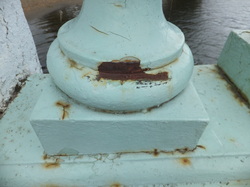Praxis I: Bridge Inspection and Improvement

Corrosion on the Centre Island Bridge
Overview: One of our earlier design activities involved another reverse engineering exercise where we were required to inspect a pedestrian bridge within the City of Toronto and determine:
The project was split into two phases: Bridge Inspection and Bridge Improvement.
My group’s bridge of focus was the triple-arched Centre Island Bridge located on the Toronto Islands, Toronto, Ontario.
These are the assignment guidelines: Assignment Guidelines
Team: Siyu Lin, Cole Millar, Toluwanimi Odemuyiwa
Process in Action: The inspection phase was much like the Tear Down Exercise we had performed earlier in Praxis studio. This phase involved starting with a finished design and going backwards in the process to determine the original purpose and problem definition for the design. In combination with the bridge improvement phase, as engineers, we were actively engaging in the testing stage and Modifying and Improving the Design stage of the engineering design process. We “tested” the design by determining how users interacted with the bridge, and realized that the design was not fully optimized for accessibility and safety. Using these shortcomings as our problem definitions, we suggested a series of solutions to further improve the design. In a sense, we looped from step seven back to step one again in my design process model.
In addition, this was my first exposure to designing within the constraints of governmental codes and standards. The project required us to evaluate the Centre Island Bridge with respect to the Ontario Structure Inspection Manual and the City of Toronto Accessibility Design Guidelines. Finally, we communicated our design to our assessors and other teams.
Links to Artifacts:
- Bridge Improvement Presentation
Below are some pictures we took during our inspection of the bridge, as well as a quote on spalling from the OSIM guide that we found relevant to the state of the bridge.
- The purpose of the bridge
- Key design features of the bridge
- The use patterns of the bridge
- The current state of repair of the bridge
The project was split into two phases: Bridge Inspection and Bridge Improvement.
My group’s bridge of focus was the triple-arched Centre Island Bridge located on the Toronto Islands, Toronto, Ontario.
These are the assignment guidelines: Assignment Guidelines
Team: Siyu Lin, Cole Millar, Toluwanimi Odemuyiwa
Process in Action: The inspection phase was much like the Tear Down Exercise we had performed earlier in Praxis studio. This phase involved starting with a finished design and going backwards in the process to determine the original purpose and problem definition for the design. In combination with the bridge improvement phase, as engineers, we were actively engaging in the testing stage and Modifying and Improving the Design stage of the engineering design process. We “tested” the design by determining how users interacted with the bridge, and realized that the design was not fully optimized for accessibility and safety. Using these shortcomings as our problem definitions, we suggested a series of solutions to further improve the design. In a sense, we looped from step seven back to step one again in my design process model.
In addition, this was my first exposure to designing within the constraints of governmental codes and standards. The project required us to evaluate the Centre Island Bridge with respect to the Ontario Structure Inspection Manual and the City of Toronto Accessibility Design Guidelines. Finally, we communicated our design to our assessors and other teams.
Links to Artifacts:
- Bridge Improvement Presentation
Below are some pictures we took during our inspection of the bridge, as well as a quote on spalling from the OSIM guide that we found relevant to the state of the bridge.
